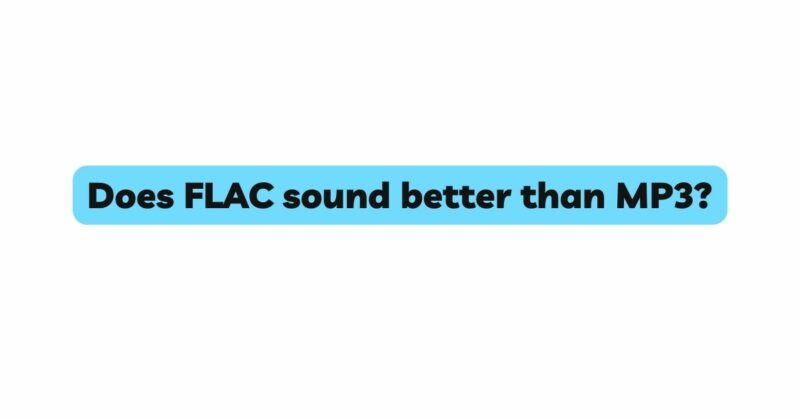In the realm of digital music, the battle between audio quality and file size has given rise to a perennial debate: Does FLAC sound better than MP3? This question delves into the heart of how we perceive and appreciate music in the digital age. This article aims to dissect the intricacies of FLAC (Free Lossless Audio Codec) and MP3 (MPEG Audio Layer III) formats, exploring the factors that influence sound quality, the perceptual nuances that set them apart, and the real-world implications for music enthusiasts seeking the ultimate auditory experience.
Understanding FLAC and MP3: Before comparing the sound quality of FLAC and MP3, it’s essential to understand their underlying technology and compression methods.
FLAC:
- FLAC is a lossless audio compression format that maintains the full audio fidelity of the original source.
- It achieves smaller file sizes without sacrificing audio quality by removing redundant data, employing predictive encoding, and using variable block sizes.
- FLAC is revered for its ability to reproduce the sound of the original recording with pinpoint accuracy.
MP3:
- MP3 is a lossy audio compression format that reduces file sizes by removing audio data that is considered less audible to the human ear.
- MP3 compression is achieved by employing psychoacoustic models that determine which audio data can be discarded without significantly affecting perceived quality.
- The trade-off for smaller file sizes is a potential loss of audio detail, particularly at lower bit rates.
Factors Influencing Sound Quality: The sound quality of digital audio formats is influenced by a multitude of factors beyond the compression method itself.
Bit Rate:
- Bit rate refers to the amount of data processed per second. Higher bit rates generally result in better sound quality.
- FLAC files can have varying bit rates, but they consistently preserve the full audio fidelity of the original recording.
- MP3 files with higher bit rates (e.g., 320 kbps) tend to offer better sound quality than lower bit rates (e.g., 128 kbps), but they still exhibit some degree of loss in audio detail.
Source Material:
- The original quality of the audio source significantly impacts the final sound quality, regardless of the chosen format.
- A high-quality source recording will retain its clarity and richness in both FLAC and MP3 formats.
- In cases where the source quality is lower, the differences between FLAC and MP3 might be less pronounced due to the inherent limitations of the source material.
Perceptual Differences: Perceptual differences between FLAC and MP3 sound quality can be subtle and nuanced, often requiring careful listening and attention to detail.
High-Frequency Detail:
- FLAC files tend to preserve high-frequency details better than MP3 files, especially at lower bit rates. This can manifest as greater clarity in cymbal crashes, vocal sibilance, and other intricate sounds.
- MP3 compression can lead to a phenomenon called “treble smearing,” where some high-frequency nuances are softened or lost.
Transparency Threshold:
- The transparency threshold refers to the point at which the difference in sound quality becomes imperceptible to the human ear.
- At higher bit rates (e.g., 320 kbps), many listeners might find it challenging to distinguish between well-encoded MP3 and FLAC files.
- The transparency threshold varies depending on factors such as listening environment, equipment quality, and individual sensitivity to sound quality.
Real-World Implications: The choice between FLAC and MP3 goes beyond mere technical specifications—it’s a decision that shapes the music-listening experience.
Audiophile Considerations:
- Audiophiles and enthusiasts who prioritize the purest audio quality often lean towards FLAC, as it offers the assurance of unaltered sound.
- Audiophile-grade equipment and high-quality headphones can reveal the subtleties that distinguish FLAC from MP3.
Storage and Accessibility:
- MP3’s smaller file sizes make it ideal for devices with limited storage space, such as smartphones.
- FLAC’s larger file sizes might limit its practicality for those with extensive music libraries and storage constraints.
Bandwidth and Streaming:
- For online streaming, where bandwidth limitations might come into play, streaming MP3 files can be more efficient and buffer-friendly compared to streaming FLAC files.
Conclusion: The Quest for Quality: The question of whether FLAC sounds better than MP3 is multifaceted and subjective. While FLAC’s lossless nature ensures that it more faithfully reproduces the original recording, the perceptual differences between well-encoded MP3 files and FLAC files might be negligible for many listeners. Factors such as bit rate, source material, equipment quality, and personal listening preferences all play a role in shaping the sound quality experience.
Ultimately, the choice between FLAC and MP3 should align with your individual priorities. If audio fidelity is paramount, and you have the storage capacity and equipment to accommodate larger files, FLAC might be your preferred choice. On the other hand, if you prioritize storage efficiency and practicality for portable devices, well-encoded MP3 files can deliver a satisfactory listening experience without compromising convenience.
As the pursuit of sound quality continues to evolve, the question of FLAC vs. MP3 reflects the broader quest to strike a balance between optimal audio fidelity and the practical realities of the digital music landscape.


